#myownthinking
Text
EOY statement:
Caden Larsen
Unnatural Habitats
2022
Sublimation, Photography, Found objects, Made garments.
I am the provocateur providing a moment. Fashion, art and the audience are my tools. My practice focuses on playing with made and found clothing, wearing them in public, making a scene and subverting people's expectations. The aim of the game is to be as loud as possible, creating a sense of visual cancellation, making people have to see you, and forcing the gaze of the viewer to inspect you the wearer, with a moment that absorbs their attention.
My practice explores play and making fun situations that spill over into the public realm. I play with camouflage and high visibility clothing to make unexpected combinations to provoke the public attention. I explore this idea through the politic of ‘carnivalesque, a term theorised by Mikhail Bakhtin 1, exploring the border between art and life and the communal performance with no boundary between performers and audience 2. I think my practice has a particular attraction to humour and curiosity, Mikhail Bakhtin discusses the idea of life shaped according to a pattern of play, and my work aims to provoke a pattern of play captured from the viewer's perspective. To expand my perspective on this politic I’ve sought understanding through the deceptive nature of hidden identity, and the ‘second life’ that public displays of wearable art can have on the viewer. The idea of the ‘second life’ is a term I have adopted from Mikhail Bakhtin, “It creates a zone in which new birth or emergence becomes possible, against the sterility of dominant norms” 3.
I see a translation of my practice into the Bakhtin’s carnival, which doesn’t exist within a single place, but more as an expression for people that aim to create their own perspectives outside existing social normality. In the carnival everything is bright, eye-catching, drawing your attention everywhere you look, over-stimulating. Everything is rendered ever-changing, playful and undefined. Conventional hierarchies are overturned through inversions, debasements and profanations, performed by normally silenced voices and energies 4. For Bakhtin, the carnival is like a safety valve for society - a space for play and fun, that lets us let off steam so that we can go back to work 5.
Statement references:
1: Michail Michajlovič Bakhtin, and Hélène Iswolsky. 1984. Rabelais and His World. Bloomington: Indiana University Press.
2: “In Theory Bakhtin: Carnival against Capital, Carnival against Power | Ceasefire Magazine.” n.d. Ceasefiremagazine.co.uk. https://ceasefiremagazine.co.uk/in-theory-bakhtin-2/.
3: “In Theory Bakhtin: Carnival against Capital, Carnival against Power | Ceasefire Magazine.” n.d. Ceasefiremagazine.co.uk. https://ceasefiremagazine.co.uk/in-theory-bakhtin-2/.
4: Michail Michajlovič Bakhtin, and Hélène Iswolsky. 1984. Rabelais and His World. Bloomington: Indiana University Press.
5: “In Theory Bakhtin: Carnival against Capital, Carnival against Power | Ceasefire Magazine.” n.d. Ceasefiremagazine.co.uk. https://ceasefiremagazine.co.uk/in-theory-bakhtin-2/.
0 notes
Photo
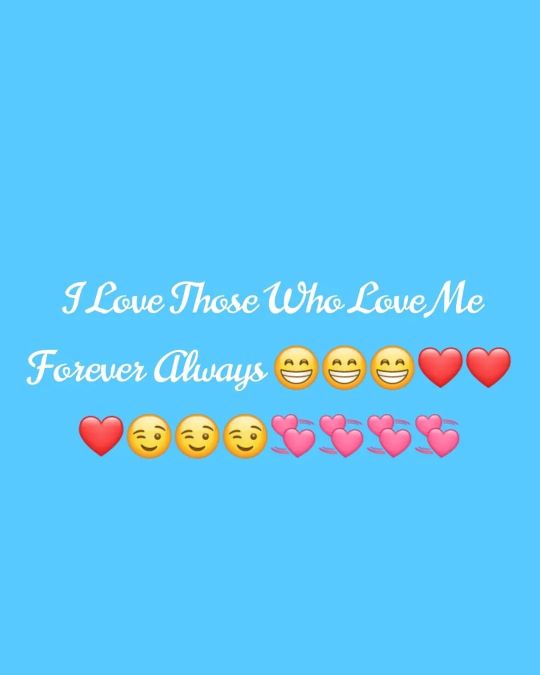
#MyOwnThinking❤️❤️❤️❤️😁😁😁😁😁✅✅✅💞💞💞😉😉😉😉😉 (at Hansi- Heart of Haryana) https://www.instagram.com/p/CpVP4LryL2n/?igshid=NGJjMDIxMWI=
0 notes
Text
Why Should I Think Like You, I Have My Own Way Of Thinking - Smart Cherry
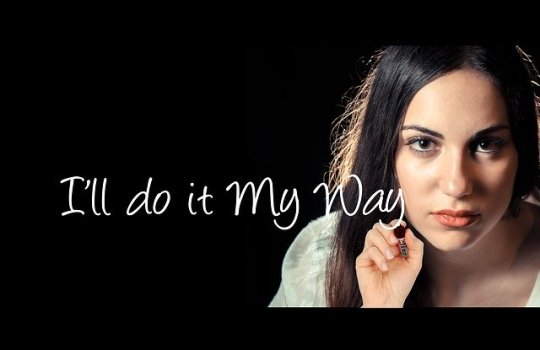
Yes, Why Should I Think Like You, I Have My Own Way Of Thinking.I Will Never Think Like You, Infact I Cannot Think Like You.
Why Will I Think Like You And Why You Are Expecting Me To Think Like You.
I Will Disappoint You Everytime Whenever You Want Me To Think Like You.
First Of All I'm Not You To Think Like You.

My Name Is Not Your Name.
My Face Is Not Like Your Face.
My Voice Is Not Like Your Voice.
My Expression Is Not Like Your Expression.
I'm Not Reacting Like You About The Things You Are Reacting In Certain Way.
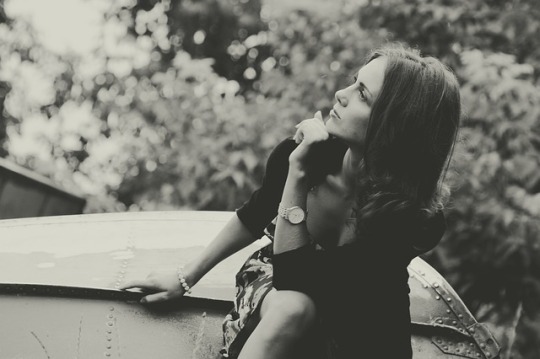
Then How Can You Force Me To Behave Like You.
How Can Attack Me For Not Being Like Your Imagination?
See, I'm Not Your Imagination, I Dont Know Your Imagination.
How Can I Be Like Your Imagination?
I'll Not Dress Like You.
I'll Not Do Whatever You Do.

I'll Eat The Same Food You Eat.
I'll Not Wake Up At The Same Time You Woke Up In The Morning.
I'll Not Agree To Every Thought To Which You Agree.
I'll Not Disagree With Every Thought To Which You Disagree.
Then How Can You Expect Me To Think And Behave Like You.

You Are Getting Diasspointed Because My Way Of Thinking Is Not Matching With Your Way Of Thinking.
The Fact You Have To Know Is One Person's Way Of Thinking Will Never Match With The Other Person's Way Of Thinking.
Dont Expect Again From Me, Stupid, I'll Disappoint You For Sure.

You Are Attacking Me For Not Thinking Like You, Are You Mad?
Are You Brainless?
Are You Headless?
Are You The Person Who Is Mentally Not Fit?
Are You The Person Who Will Never Use Your Brain?

If You Attack Me For Not Thinking Like You, I'll Attack Anybody Who Attacks Me For Being Myself For Sure.
I Hope You Got My Point.
Smart Cherry..!
Read the full article
#myownthinking#ownthinking#ownthinkingdefinition#ownthinkingquotes#ownthinkingsynonyms#ownwishfulthinking#theirownthinking#thinkingownideas#thinkingownlife#yourownthinking
0 notes
Text
My favourite thing in the world is to walk to a park near a road that will be busy at the time of day when everyone is heading home from work. I sit there in that park where all you can hear is the cars driving past and the occasional gust of wind and i just watch. I watch as people are rushing home to their families, pets or even just the news. As i sit there in peace as everyone else rushes around me, it makes me realise that even in the busiest, craziest and hardest times you can always find peace and happiness somewhere.
0 notes
Text
Updated install plan
This is a updated version of my install plan for EOY, I'm trying to flesh out a more formal reading of the peacock and magpie idea, by adding relevant features found on both birds.
Nest Sculpture:
The idea with this sculpture is to create a nest of collected clothing from my wardrobe is a colorful mesh of found and made objects. The beach tent will be covered in sublimations of my garments warn in unnatural habitats. Inside the beach tent is a chrome spray painted mannequin head which building a connection to magpies and there love for shiny objects. While also the head is a metaphor for the attraction of the public when wearing my garments. The eyes on the inside of the tent symbolize the public gaze on me when wearing these garments, and also acting as a way to further the meaning of the chrome head metaphor. The eyes also are a reference to the eyes found on peacocks used for display, but also as a protection method to deter bigger animals.
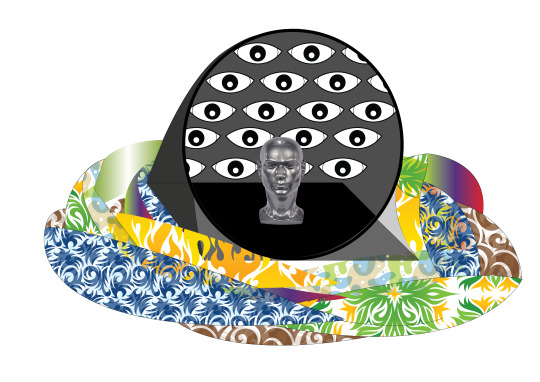
The Scarecrow and the head:
Again I wanted to build figurative meaning into this sculpture as well, in this case playing on the scarecrow's connection to magpies. This sculpture acts a opposite to the nest sculpture, by deterring the magpie away. This sculpture also features a tree form that the scarecrow sits on, the tree is covered in a peacock pattern, and due it its size creates the size deterrent that the the peacocks feathers feature. The scarecrow its self features a giant 25 xlarge hoodie, again playing on how the size of the peacocks display intimidates other animals. The sculpture on the bottom is a head covered in sublimations of my garments worn in unnatural habitats, all the images feature people looking with interest or confusion. The scarecrow then acts as a way of putting pressure on the wearer, and how my garments require a confidence or self worth to be worn.
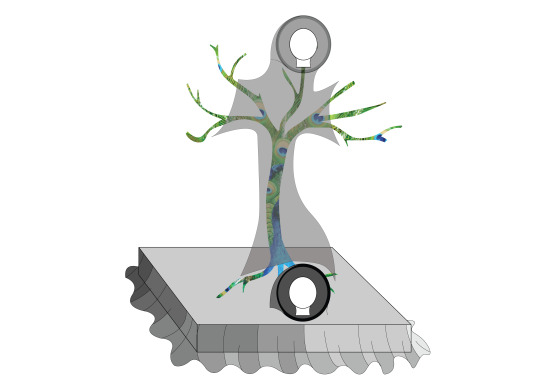
Sublimation picture examples:



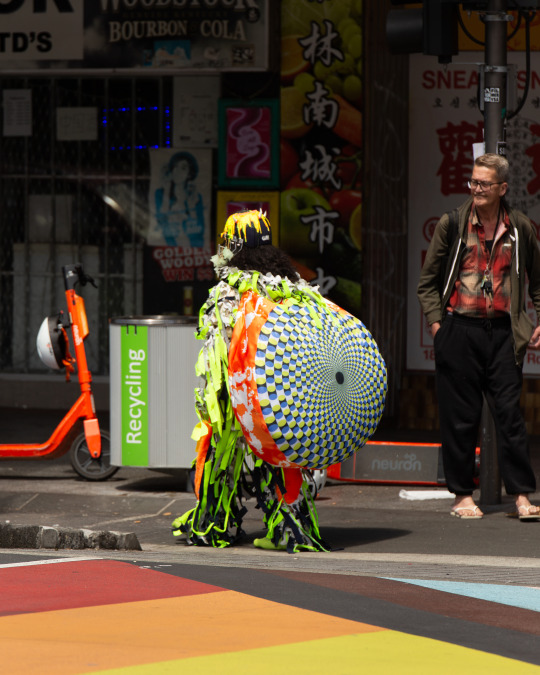
25xlarge hoodie panels:

0 notes
Text
Isa Genzken and Magpieing
Carnivalesque isn’t just a moment, it can be a whole lifetime. Once you have a clear idea of your identity, living life in a world of day to day wearable art becomes a normality. Treating each day as a runway show becomes a right of passage, as a method of engagement with your pairs and with the ever changing audience that encroaches into your understanding. To discuss this idea further we can look at Isa Genzken’s approach, in her series I love Micheal Asher. By exhibiting some of her personal outfits, this work references the artist’s way of living and explores how objects and garments in your day-to-day life can exist with and as art. The I love Micheal Asher series creates a dominant connection to both her studio and life by adding objects that are found in her world. While these outfits and garments may appear quite unusual to most viewers, for Genzken it’s a way of allowing the audience to directly interact with her world. Whether it’s clothing, plinths, mannequins, or random objects she has lying around, the purpose of this practice is to create a form of authenticity. This is similar in my practice, the garments I place in the space act as a way of bringing the audience into my world, allowing them to build an idea of my fashion identity without me being in the space.
In Hauser Wirth & Schimmel, Los Angeles, 2016, Genzken wrote in large letters “Genzken was here.” scribing phrases like “SIENCE FICKTION” and “FUCK OUI” on postal scraps and material from her studio. This convention of ownership of her work translates into my practice. In a similar way to the seemingly random arrangement of clothing and materials in ‘I love Micheal Asher’ I draw connection to the collecting and collection process that adds authentication, and identity to the work. Within my install experiments this year there is the mashing of found and made objects. This mashing creates a birds nest effect of objects much like a magpie. The cultural truism of magpies finding shiny, pretty, things to collect can be compared to how both Gensken and I find interesting garments that add fun and joy to my everyday life. Interestingly the idea of ‘magpieing’ is quite prominent in a lot of her exhibitions.
In a review of the exhibit by Travis Diehl, the reviewer acknowledges that, “The setup doesn’t just mimic; nearly every object has been shipped from Genzken’s studio in Berlin, down to the ledge itself”. Genzken’s work as “imported”, and I see a direct correlation to the collected and found objects that I use in my work. The diversity of garments from all around the world that coexist with the space is a direct example of a fashion ‘magpies’ unbridled thirst to capture their next pretty object to add to their nest. The nest becomes a way of not just building an identity for the collector, but as a snapshot of the audience to understand the inner workings of the artist’s habits and interests.
0 notes
Text
Practitioners connection to collecting
Hugh Hayden, who discusses his love for hunting and collecting. More specifically his obsession with feathers, which translates into his sculptural work. Like Isa Genzken his feathers are imported and found, creating a deeper meaning of the feathers not only being used to create a new object. But creating an object that is displaced from its natural habitat.
Nick Cave also expresses a connection to collecting in an interview with Willis Ryder Arnold, stating that he started collecting when he was 18 years old when I was in undergraduate school. This interview was particularly interesting due to the nature of his collection as he has gotten older. Nick Cave discusses “how am I going to collect at this point?” My living space is very curated; it’s only what I want to look at every day. No matter which direction I turn in my living space it’s something that I want to see”. This Quote has a strong connection to the concept of a fashion magpie, because the goal is always to surround myself with objects and garments that make me happy, or show off my identity.
0 notes
Text
Birds?
Magpies and Peacocking:
My work seems to have an affiliation with birds, both magpie's and peacock's seem to fit into my practitioners. Hugh, Isa and Nick all seem to be collectors, similarly to magpies they collect objects that they think are important to them, and display them in there own versions of nests, that seem like different installs. The artists all display version of peacocking too, whether its displaying objects that are bright and colourful, or using there objects shape, size and colour to create deceptions. Much like how the peacock enlarges its self with its feathers. Hugh has the biggest connection being a hunter who collects feathers, directly connecting him to the bird theme on a formal level. What I find most interesting is that I hadn't really thought about how birds play an integral role in my practice, and how there different approaches are all connected to birds.
0 notes
Text
'Second Life'
Nick Cave's work also disguises the identity or intention of his sculptures, but in a slightly different way where he disguises the true identity of the wearer. Being himself a queer black man, his ongoing project titled Soundsuits, allows the wearer to enter a second identity free of preconceived judgement. Cave began making Soundsuits in response to the Rodney King murder and following LA Riots, at a time when identity and appearance could be a very charged and dangerous situation for black and queer people in America. Cave’s Soundsuits allow him to mask his identity from judgment, being queer was not as accepted in the 1990's in comparison to now, and years of racial and economic inequality spilled over into the streets, resulting in five days of rioting in Los Angeles, coinciding with the beginning of Nick Cave’s ‘Soundsuits’ creation. Nick Cave hid his identity for safety, protection from discrimination. Nick Cave has used a lot of queer, different, and unique models, which helps they to hid from discrimination.
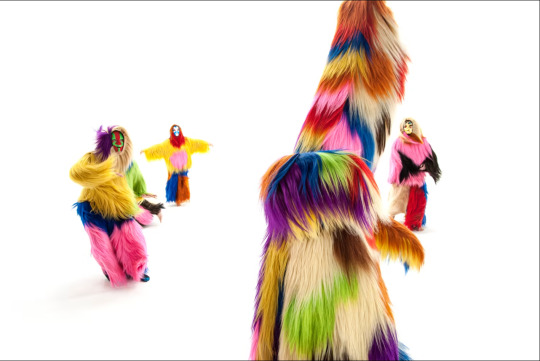
In Andrew Robinson’s analysis of Rabelais and his World, Mikhail Bakhtin portrays carnival as an expression of a ‘second life’ of the people, against their subsumption in the dominant ideology. In this idea, ‘second life’ refers to how clothing or an environment can create a new identity for a person. In many ways I see similarities with the expression of a ‘second life’, and both Cave and my practice. But we approach the interpretation of ‘second life’ differently. Cave’s continuing creation of the ‘soundsuit’ collection is a reflection of his approach to this idea, however Cave refers to the idea as ‘second skin’.
Borrowing Cave's description of 'costume' for his Soundsuits, I find the 'costume' allows me to express how I feel rather than hide from people's opinions. Like a superman suit, it gives people the confidence that they can be who they want without preconceptions determined but their posture, mannerisms, and voice. This gives me a new understanding of the title Soundsuits', when something is sound it's safe, secure, air tight, while also acting as a physical reference to a soundproof room where none of the preconceptions of identity can escape.
I think the big similarity between me and Nick Cave is the idea of uncertainty. Uncertain of how people will see me; uncertain of the future; and uncertain of how we fit into the bigger picture. Where we differ though is the level of uncertainty, our problems are mediocre compared to Nick Cave's in 1992, because individuality is more accepted in 2022. Where our perspectives differ is that I hide my identity as a form of confidence. The clothing allows the wearer to create a new persona, this builds a sense of confidence due to either positive public reaction, the ability loud clothing has to mask preconceived bios of the wearer. Cave loud costumes create a shield over the wearer to obstruct judgement, only allowing the viewer a surface level reading, being the loud clothing. But most importantly, when you're proud of what you are wearing it impacts how you see yourself, this pride creates a sense of confidence when you wear clothing you love.
0 notes
Text
Ghillie and Costume
Within my practice a lot of my made garments seek to rethink the preconceptions of a garment, following the methodology of dislocation and relocation, which I treat as a form of redirection or reappropriation of an existing idea. One approach to causing this thought is to mess with preconceptions of very specific pieces of clothing. Like Hugh I have an obsession with hunting, but not the hunt itself, I'm more interested in tha hunting apparel. My first creation for the year was a reinterpretation of a ghillie suit, a terrain based garment meant to visually obstruct the wear from what they are hunting or hiding from. Much like a disguise, ghillie suit’s are traditionally built with brush and fibres from the surrounding area, to help blend into the environment.
For this approach I drew from the ‘second life’ hidden meaning that Hugh creates with his work, to counter the preconceptions of a traditional ghillie suit, with the intention to make it as bright and loud as possible. To create this adaptation I needed something that's purpose was to be seen. The construction Hi-Vis uniform proved the perfect vessel, as the ghillie’s loose material and innate lack of mobility allowed me to also counter the wearability and usability of traditional workwear. This garment or Hi-Vis ghillie suit does everything in its power to counter the preconceptions of its preexisting counterparts. By doing this dislocation and relocation of context, the intended purpose of both Hi-Vis and the aspect of hiding the ghillie is meant for. This innately also created a ‘second life’ for the construction uniform upcycled to create the brush and fibres found on traditional ghillie suits, which acted as a nod to traditional ghillie suits use of organic material found in the area of its intended use.
Sublimated shirt:

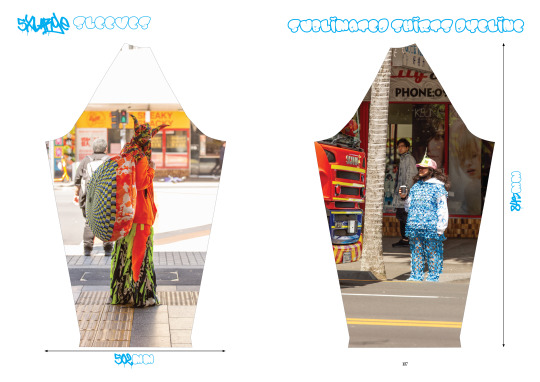

Sublimated 25 Xlarge hoodie:
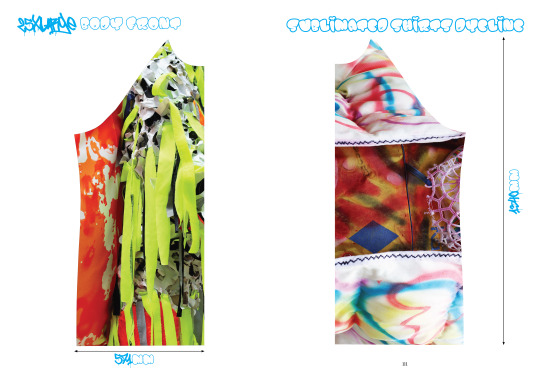


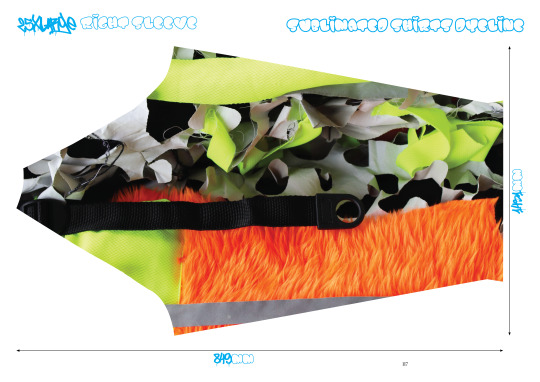
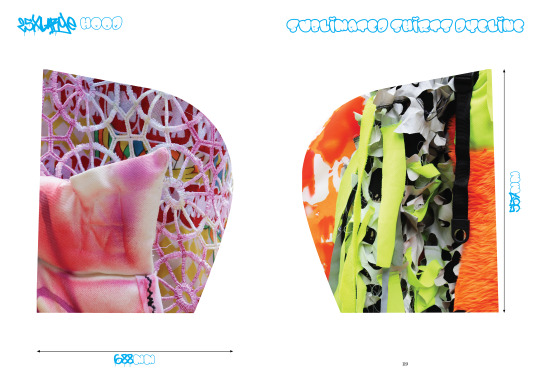
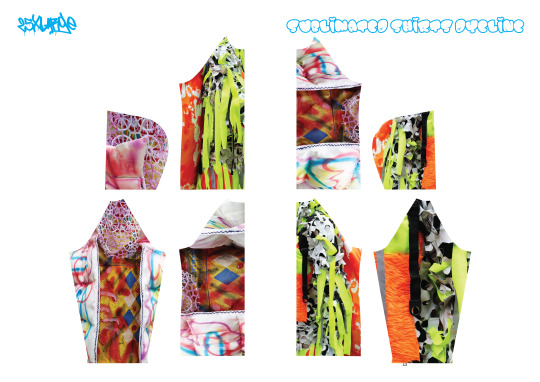
Sublimated full panel images:
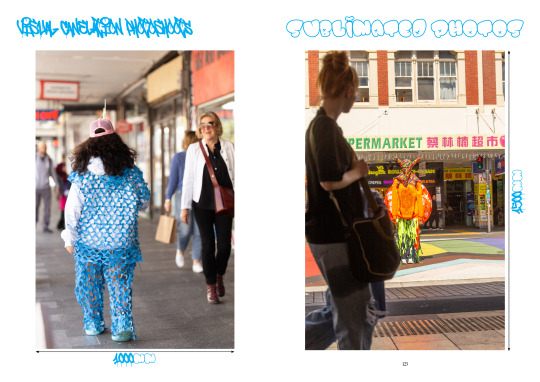
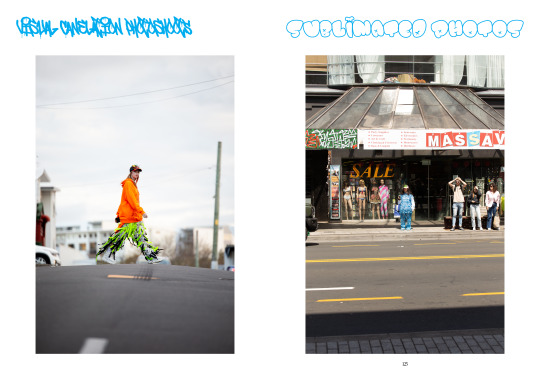

0 notes
Text
Research summery: Notes from lectures from draft 1
1- It might be useful to do some very straight forward discussion of your studio practice at the beginning.What is your field of research? What kinds of things do you make? What materials do you use? What are your favorite ideas that you like to work with? This will help you to frame your discussion of the work that you are referencing. If you had to explain your work to an 11 year old what would you say?
"When exploring this concept contextually I drew a connection between Hugh Hayden and Nick Cave’s work."
Classically in an essay you can draw a connection between these artist- but you would need to introduce each one in their on terms first- think of an essay as a flow chart- we can't add A to B if we don't know what A is or B is, so you have to go through each bit step by step. You can plan an essay out in this way- each step is a paragraph: Introduce A, Introduce B, Compare A+B, Contrast A+B.
It's good to assume that your audience is not familiar with your references so it can be very helpful to include a little pointer that can frame the discussion. Something like American Sculptor Hugh Hayden- or Noted Performance artist NIck Cave- and this case make clear its the American performance artist and not the Australian singer. A little clue like that really helps.
"Hugh Hayden disguises the identity of his objects by hiding them in plain sight, with only a trained eye being able to pick them up." Too brief and not clear enough- describe the work a little bit more- what does it look like, what is it made of, how do you read it?
"Assimilation" in race theory assimilation is the idea of all the colonised identities shifting to become indistinguishable from the colonising identity- ie it is a much more politically loaded term than the way you are using it here. Assimilation has been abandoned as a government policy in NZ in favor of biculturalism and multiculuralism- the celebration of diversity etc.
Speaking of Kings and jesters- it might be helpful to look at the Russian literary critic Mikhail Bakhtin and his theory of the carnivalesque- relevant to any discussion of clowns but also anytime you are upsetting the usual run of things. For Bakhtin the carnival is like a safety valve for society- a a space for play and fun, that lets us let off steam so that we can go back to work.
"we might say that carnival is expressive rather than instrumental. It involves the expression of latent aspects of humanity, direct contact among people (as opposed to alienation), and an eccentric refusal of social roles. It brings together groups and categories which are usually exclusive. Time and space are rearranged in ways which show their contingency and indissolubility. All of this is done in a mood of celebration and laughter.
In carnival, everything is rendered ever-changing, playful and undefined. Hierarchies are overturned through inversions, debasements and profanations, performed by normally silenced voices and energies.
For instance, a jester might be crowned in place of a king. The authoritative voice of the dominant discourse loses its privilege. Humour is counterposed to the seriousness of officialdom in such a way as to subvert it."
I don't think apolitical is a good position to claim- too privileged, more to do with the luxury of not having to think too hard about politics- the carnivalesque is better- the inversion and refusal of hierachies- fits the role of the provocateur without needing a specific politic.
"Here on the right she has displayed a lot of garments from her wardrobe, creating this connection or deeper understanding of the artist's identity. "
more description would be helpful- how are the clothes displayed? what do the outfits look like?
0 notes
Text
youtube
Watch the American Climate Leadership Awards 2024 now: https://youtu.be/bWiW4Rp8vF0?feature=shared
The American Climate Leadership Awards 2024 broadcast recording is now available on ecoAmerica's YouTube channel for viewers to be inspired by active climate leaders. Watch to find out which finalist received the $50,000 grand prize! Hosted by Vanessa Hauc and featuring Bill McKibben and Katharine Hayhoe!
#ACLA24#ACLA24Leaders#youtube#youtube video#climate leaders#climate solutions#climate action#climate and environment#climate#climate change#climate and health#climate blog#climate justice#climate news#weather and climate#environmental news#environment#environmental awareness#environment and health#environmental#environmental issues#environmental justice#environment protection#environmental health#Youtube
17K notes
·
View notes
Text
Research Summery: Draft 1
Introduction:
I am the provocateur providing that moment, wearable art and the audience are my tools. A Lot of these moments are so strong because you're causing the viewer to build an understanding of who you are, and why you're drawing their attention. One approach to causing this thought is to mess with preconceptions that very specific pieces of clothing have.
I think my practice has a particular attraction to humour and curiosity, it's a way of laughing at people that are quite stuck up and serious, have a particular way a garment must be seen or made, or someone who's quick enough to get the joke.
The aim of the game is to be as loud and obnoxious as possible, make people have to see you, and cause them to inspect you the wearer, with confusion or admiration.
Within my research this year I explore the power of identity, the apolitical jester, and the ability to to draw attention.
PARAGRAPH: Hugh, Nick and I
When figuring out the best way to approach rethinking the preconceptions of a garment, I tend to stick to the idea of dislocation and relocation, which also could be seen as deconstruction and reconstruction. The reason why I chose to word it as such though is it doesn't feel like something being pulled apart and put back together, it's more of a redirection or reappropriation of an existing idea. The thought behind this is to provoke the viewer into a moment of discussion with either the pairs or themselves.
One approach to causing this thought is to mess with preconceptions that very specific pieces of clothing have. My first creation for the year was a reinterpretation of the construction Hi Vis uniform. I created an adaptation of the uniform to counter the wearability and usability of workwear.
Within the already muddled idea of what a Hi Vis uniform should look like, is a second idea, a humour, or inside joke if you will. The joke is for any viewers that know what a Ghillie suit is, which is a military garment traditionally built to hide the wearer in their environment. This garment or Hi Vis ghillie suit does everything in its power to counter the preconceptions of its preexisting counterparts.
When exploring this concept contextually I drew a connection between Hugh Hayden and Nick Cave’s work. Hugh Hayden loves to work with these hidden ideas or jokes that only a person with an intuitive eye would probably pick up on. Like this example titled ‘really pretty’, that has a ‘diet coke’ logo hidden right in the centre.
Hugh Hayden disguises the identity of his objects by hiding them in plain sight, with only a trained eye being able to pick them up. Nick Cave's work also disguises the identity of his objects, but in a slightly different way where he disguises the true identity of the wearer. Both these artists use deception to either trick the viewer or disguise the true meaning hidden in the objects.
I think the big similarity between me and Nick Cave is the idea of uncertainty. Uncertain of how people will see me, Uncertain of the future, and Uncertain of how we fit into the bigger picture. Where we differ though is the level of uncertainty, our problems are mediocre compared to Nick Cave's in 1992, I hide my identity as a form of confidence. The 'Costume' allows me to express how I feel rather than hide from people's opinions. Nick Cave though hides his identity from judgment, being queer was not as accepted in the 1990's in comparison to now, and years of racial and economic inequality spilled over into the streets, resulting in five days of rioting in Los Angeles, coinciding with the beginning of Nick Cave’s Sound Suit creations. Nick Cave hid his identity for safety, protection from discrimination. Nick Cave has used a lot of queer, different, and unique models, which helps they to hid from discrimination. Like a superman suit, it gives them the confidence that they can be who they want without preconceptions determined but their posture, mannerisms, and voice. This gives me a new understanding of the term 'sound suit', when something is sound its safe, secure, air tight, while also acting as a physical reference to a soundproof room where none of the preconceptions of identity can escape.
PARAGRAPH: Hugh and Peacocking
In an interview with Hugh Hayden titled The Fine, Feathered Hugh Hayden, I began to flesh out this idea of ‘natural peacocking’. Traditionally peacocking in a human setting is seen as a way of males showing off to attract the attention of females, but I think for me the concept is much broader than that. This idea started to expand when reading through The Fine, Feathered Hugh Hayden interview. Where he describes a likeness to clothing and feathers stating, “For us, clothing isn’t an organ, but for humans, it’s often sort of this artificial organ that humans have created to cover the body. It functions how other things function for birds”
If we scrap back this idea to its core, peacocking is to attract attention, allowing clothing to function as a form of feathers, much like how feathers are an external organ that birds use for both function and display.
Hugh Hayden in the same interview Fine, Feathered Hugh Hayden talks about this idea of ‘assimilate’, or ‘assimilation’. By definition to assimilate is to take in and understand information or ideas. But I think in terms of a social environment it has a lot to do with this idea of balance between blending in and standing out. I think this idea also follows the concept of birds. Hugh states that “There’s this blur between the social and the natural environment, specific families of humans that have created their own official identification systems, that they’ve evolved over time. They’ve balanced and blended into their specific environment, much like birds do as they evolve to different climates. We also do things to assimilate to our natural environment. It’s about protection from predators. Hugh made this allegory from this natural evolution of birds and nature to the social environment that humans create cultural assimilation into groups”. I think assimilation blends my idea of dislocation and relocation into a single term. The dislocation being understanding its intended purpose, while the relocation is absorbing the idea and redirecting its purpose to achieve a style that is best acclimated to the environment the wearer is in, and how much they want to stand out.
Wearable art is an expressive way of presenting yourself without fear or limitation. To continue my thought, Hugh Hayden says in this small paragraph. “Sometimes people see the work completely differently. A lot of it exists in the subconscious. Someone might make a comment about something that could have been in my subconscious… I enjoy learning from the readings''. When interacting with the public, reading people's emotions becomes a lot easier when you wear something out of their comfort zone. Their thoughts bubble to the surface as forms of expression, which usually only exist within the subconscious of the viewer. Whether it's something they wished they had worn, a fad that they have seen before, or in a lot of cases something they don't think they can ‘pull it off’. I think there is a level of swagger required to walk around comfortably in these garments, and that is a lot to do with the subconscious of the wearer. How they perceive themselves, and if they could see them wearing the garment even before it's been worn.
PARAGRAPH: Jester and Ugo
The jester is a powerful figure in the mediaeval hierarchy, although they are the fool, they are the only person who can openly laugh at the king.
OPINION 1:
When unpacking this idea I’ve always thought my practice focused more as the provocateur providing a moment for the viewer. In a lot of ways in those moments I am the jester, but in my practice I think I see myself also as the king. Not in the self loathing way but more the public are the audience for a jester show to himself. Why I also see this is the king is from the audience perspective, with some of the things I wear I may seem deranged or out of the ordinary. Yes the jester character is known for wearing strange clothing, but there is a sense of confidence the king carries, and when thinking about the attitude that the clothing creates, it's a type of power that only someone that is content with themselves can 'pull off’.
OPINION 2:
While thinking about the idea above I believe there is a second stance on who the jester is in my world, and who the audience is. In my first opinion I argued that I was both the jester and the king. But it could also be seen as I’m the jester and the public are the king. I’m tempted to think this interpretation is better, because it sees the public as a powerful figure that can only be laughed at by someone who understands their identity. The jester in both scenarios is the fool, making people laugh, smile, and drawing the attention of the public. Where my practice differs from the traditional jester comes due to the respect that the audience has for the uniqueness of the jester. It's less of laughing at the jester, but more laughing with the jester at the bland world that surrounds us. That opinion is very much based on the audience though, the places I wear my garments aren’t in a corporate business meeting, but I argue that isn’t a public space. So in terms of public audience I think this perspective stands.
AN APOLITICAL JESTER
By definition Apoliticism is apathy or antipathy towards all political affiliations. A person may be described as apolitical if they are uninterested or uninvolved in politics. Being apolitical can also refer to situations in which people take an unbiased position in regard to political matters.
AN UNBIASED POSITION:Innately I don’t have politics, however that doesn’t mean the audience doesn’t. As the jester, the provocateur, my job is to provoke the viewers' politics. But what’s more interesting is that I am able to manipulate their perspective. Making the viewer see what you want them to see and think it's their own opinion, when in reality it's a form of group decision making controlled by the provocateur, this builds power the more individuals get involved, like a chain reaction.
UGO RONDINONE:
Tricking the viewer or disguise the true meaning hidden in the objects. This also resonates with my investigation of Ugo Rondinone’s install “Vocabulary of Solitude”. I discussed the idea that the artwork is a series of life-like static clowns, posing in positions of thought, or pondering. From the outside perspective they are clowns, an image of joy, laugher, and absorbent amounts of energy. Yet in this work they are static and paired with individual unique disassociated or sombre faces. These two juxtaposing concepts of a symbol of joy, that portrays a face in deep thought, speaks to a similar idea of Nick Cave’s costumes masking the true identity of the wearer, as well as Hugh Hayden’s masking of the material of his objects.
PARAGRAPH: Isa Genzken and Found Objects
When pushing into this world of day to day wearable art, and treating each day as a runway show. I see my practice as more of a blend between Isa Genzken’s attitude with Nick Cave’s outrageousness. Isa Genzken in her series ‘I love Micheal Asher’, explores how objects and garments in your day to day life can exist as art. Here on the right she has displayed a lot of garments from her wardrobe, creating this connection or deeper understanding of the artist's identity. I personally see myself as a maximalist, and I believe that comes through in my attitude towards this wearable art being able to be day to day clothing.
Which leads me into this idea of the inevitable pipe dream. A pipe dream is referred to as an unattainable thought that eludes the reach of the thinker, something that either they see as impossible, or something that they could never see themselves achieving. Wearing wearable art as a day to day garment pushes the viewer out of their comfort zone, challenging the perceiver to question whether the person is wearing sculpture or fashion. With the goal being to force the viewer to create a stance on the wearability, functionality, and question the viewer's perspective of self.
An inevitable pipe dream is innately a glass half full or half empty term, based on the viewer's perspective. The perception of the interpretation of ‘inevitable’ creates either a double negative, or an unavoidable positive outcome depending on the interpretation. There begins to be this blur between found and made objects as the outfits explore fashion that require courage and pride to be worn, causing the viewer to ponder whether they could see themselves in public wearing these objects. This moment of ponder is the inevitable moment, the viewer decides if they are looking at a sculpture, or everyday fashion. A synonym for a pipe dream can be seen as a daydream, an inevitable pipe dream version are moments that feel like daydreams, tangible moments that exist between fantasy and reality. These moments are what drive me to continue my practice. The adrenaline of not fitting in, and how far I can push the viewer mentally in a moment or glance.
The positive influence a confident person can have on another person's identity is infectious, and maybe that's the true ability of peacocking. Maybe this thought is based on perspective, for me it is a way of fitting into the creative environment that surrounds me, keeping me intune with the social media, and people that I surround myself with. From an outside perspective it's seen as me opposing what's around me, or intentionally wearing something to provoke the perceiver, but for me it's acclimatising to my desired environment.
CONCLUSION:
“They’ve evolved over time. They’ve balanced and they’re blending into the environment. We also do things to assimilate to our natural environment. It’s about protection from predators. I made this allegory from this natural evolution of birds and nature to the social environment that humans create by assimilating culture into groups”. I think the best innalergy I can use that adapts this quote from Hugh Hayden, in terms of standing out, but blending into your intended environment. Would be the example of a tigers orange colouration, and their tendency to hunt dichromats (state of having two types of functioning colour receptors). Animals such deer, boars, and other ungulates are mostly affected by this, as they are unable to perceive the colour orange, hence why this colour is used alot in hunting. Whilst as humans we have four colour receptors, allowing us to perceive orange, the fundamental idea around suiting your environment remains the same. Much like a bird's feathers the tiger's orange coat can be treated as an external organ, not only does it blend in perfectly with its natural environment for its prey, it stands out to any other creature that receives with more than two colour receptors. To work out how this adapts into an urban social setting, let's think about the other intention of the tiger's orange colouration. By being this bright and exuberate colour it allows the tiger to tell creatures that can perceive orange that they should beware it, kind of like wearing caution tape. For humans that has a different effect though, if we dislocate a piece of clothing from its intended purpose. Or we purposely stand out; we are now hunting creatures that can perceive ‘orange’, and use the creatures that can't see ‘orange’ as tools to enhance the desired effect. I The provocateur relocate the viewer's perspective, and wearable art is my tool.
0 notes
Text
Install development and deeper meaning
I think its important to build the conceptual meaning of my pieces, on the surface I like the idea that the pieces tell a story. But I want to work on building a deeper meaning.
I started thinking about my idea to have white mannequin heads, surrounded by two fully accessorized heads. I began to see the white heads as a form of white noise, and how the heads work as a form of visual cancelation.

So I've been thinking about how to make this idea the most achievable in time frame I have. When talking to my family they said, 'instead of building a frame, why don't you just used a beach tent'. I laughed a bit because it was such a good idea, I would save me lots of time, and so far I'm thinking of sewing the sublimations onto the beach tent. Also I think using a black tent will be the best way to build the idea, and potentially some lighting on the inside of the tent.


I'm also debating weather I need a base for the tent or not, I actually like the height that the base gives. I think the graffiti base too, it give it a bit of a urban concrete feel, I think ill play around with some different bases and weather or not its important yet.
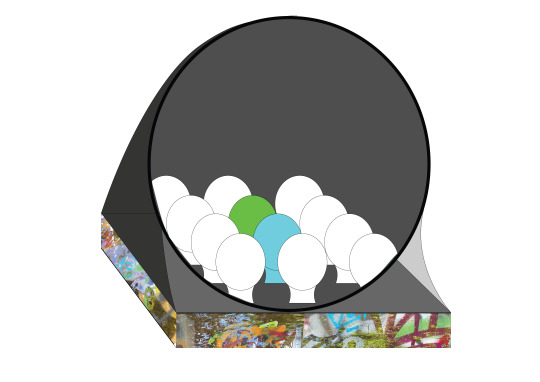
0 notes
Text
An Apolitical Jester
By definition Apoliticism is apathy or antipathy towards all political affiliations. A person may be described as apolitical if they are uninterested or uninvolved in politics. Being apolitical can also refer to situations in which people take an unbiased position in regard to political matters.
An unbiased position:
Innately I don't have a politic, however that doesn't mean the audience doesn't. As the jester, the provocateur my job is to provoke the viewers politic. But what's more interesting is that I am able to manipulate there perspective. Making the viewer see what you want them to see and think its there own opinion, when in reality its a form of group decision making controlled by the provocateur, this builds power the more individuals get involved, like a chain reaction.
0 notes
Text
Display Development
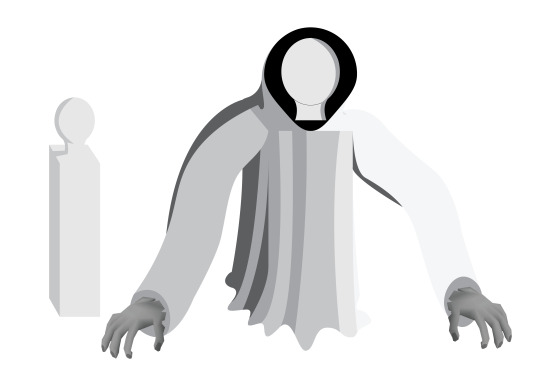
Thinking:
I thought I'd just flesh out the idea of having big hands on the bottom of the sculpture, and a scale dummy of my the general size I want the sculpture to be. I'm going to need to figure out some way to puff the arms up, or else they will drape and look a bit strange. I terms of building a humanoid form I think its important to have a good structure, because it will add a lot to the effect the form gives.
0 notes
Text
youtube
Watch the 2024 American Climate Leadership Awards for High School Students now: https://youtu.be/5C-bb9PoRLc
The recording is now available on ecoAmerica's YouTube channel for viewers to be inspired by student climate leaders! Join Aishah-Nyeta Brown & Jerome Foster II and be inspired by student climate leaders as we recognize the High School Student finalists. Watch now to find out which student received the $25,000 grand prize and top recognition!
#ACLA24#ACLA24HighSchoolStudents#youtube#youtube video#climate leaders#climate solutions#climate action#climate and environment#climate#climate change#climate and health#climate blog#climate justice#climate news#weather and climate#environmental news#environment#environmental awareness#environment and health#environmental#environmental issues#environmental education#environmental justice#environmental protection#environmental health#high school students#high school#youth#youth of america#school
18K notes
·
View notes